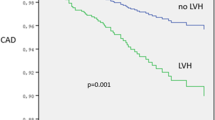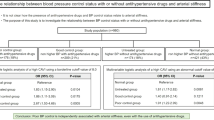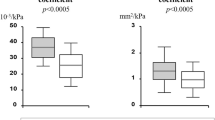Abstract
In middle-age hypertensives from the Gubbio Population Study, we evaluated the relationship between blood pressure (BP) control over a long time and the prevalence of left ventricular hypertrophy (LVH). A population survey was performed in 1982–1985 and repeated in 1989–1992. During the second survey, subjects in the age range 40–60 years were invited to undergo an M-mode echocardiographic examination. A total of 487 subjects who participated in both surveys are included in the present analysis. Some of them (294) were normotensive (Group 1), 110 were hypertensive but had never taken antihypertensive drugs (Group 2), 47 hypertensives on drugs were in good BP control (Group 3) and 36 hypertensives on drugs had uncontrolled hypertension (Group 4). BP values at the 1989–1992 examination were, respectively, 122/77, 145/86, 124/78 and 153/91 mmHg, while 7 years earlier were 122/77, 133/84, 136/85 and 152/95 mmHg. Despite normal BP levels in Group 3, left ventricular mass index (LVMi, g/m2.7) was greater than in normotensives (42.4±10, 46.6±13, 47.0±10, 51.9±15 g/m2.7). Accordingly, the prevalence of LVH (LVMi >51 g/m2.7) was 18, 26.4, 36.7 and 50% in groups 1–4, respectively. The 193 hypertensives were, thereafter, divided according to BP control (ie <140/90 mmHg) on both surveys (1983–1985 and 1989–1992): 27 hypertensives with optimal BP levels on both visits also had a ventricular mass similar to normotensives and significantly lower than the other hypertensives (LVMi 44.6±11.6 vs 48.5±13.2, P<0.001). In conclusion, these findings indicate that hypertensive patients with BP values at levels similar to those in normotensives for a long period do not increase their left ventricular mass in comparison to subjects with normal BP levels.
This is a preview of subscription content, access via your institution
Access options
Subscribe to this journal
Receive 12 digital issues and online access to articles
$119.00 per year
only $9.92 per issue
Buy this article
- Purchase on Springer Link
- Instant access to full article PDF
Prices may be subject to local taxes which are calculated during checkout
Similar content being viewed by others
References
Korner PI, Jennings GL . Assessment of prevalence of left ventricular hypertrophy in hypertension. J Hypertens 1998; 16: 715–723.
Levy D et al. Prognostic implications of echocardiographically determined left ventricular mass in the Framingham Heart Study. N Engl J Med 1990; 322: 1561–1566.
Kannel WB . Hypertension and other risk factors in coronary heart disease. Am Heart J 1987; 114: 918–925.
Kannel WB, Wolf PA, Verter J . Epidemiologic assessment of the role of blood pressure in stroke. JAMA 1970; 214: 301–310.
Roberts WC . Frequency of systemic hypertension in various cardiovascular diseases. In: Laragh J, Brenner B (eds). Hypertension: Pathophysiology, Diagnosis and Management. Raven Press Publisher: New York, NY, 1990, pp 379–387.
Laurenzi M, Trevisan M . Sodium–lithium countertransport and blood pressure: the Gubbio Population Study. Hypertension 1989; 13: 408–415.
Menotti A et al. Impact of the Gubbio Population Study on community control of blood pressure and hypertension. Gubbio Study Research Group. J Hypertens 2001; 19: 843–850.
Laurezi M et al. Gubbio Population Study: baseline findings. Nutr Met Cardiovasc Dis 1991; 19: 843–850.
Sahn DJ, De Maria A, Kisslo J, Weyman A . The Committee on M-mode standardization of the American Society of Echocardiography: recommendations regarding quantitation in M-mode echocardiography: results of a survey of echocardiographic measurements. Circulation 1978; 58: 1072–1083.
Devereux RB, Reichek N . Echocardiographic determination of left ventricular mass in man: anatomic validation of the method. Circulation 1977; 63: 613–618.
de Simone G et al. Left ventricular mass and body size in normotensive children and adults: assessment of allometric relations and impact of overweight. J Am Coll Cardiol 1992; 20: 1251–1260.
Dubois D, Dubois EF . A formula to estimate the approximate surface area if height and weight be known. Arch Int Med 1916; 17: 863–871.
De Simone G et al. Effect of growth on variability of left ventricular mass: assessment of allometric signals in adults and children and their capacity to predict cardiovascular risk. J Am Coll Cardiol 1995; 25: 1056–1062.
Roman MJ et al. Association of carotid atherosclerosis and left ventricular hypertrophy. J Am Coll Cardiol 1995; 25: 83–90.
Ferrara LA et al. Is there a relationship between left ventricular mass and plasma glucose and lipids independent of body mass index? Results from the Gubbio Study. Nutr Met Cardiovac Dis 2003; 13: 126–132.
Schirmer H, Lunde P, Rasmussen K . Prevalence of left ventricular hypertrophy in general population. The Tromsø Study. Eur Heart J 1999; 20: 429–438.
Giampaoli S, Vanuzzo D . Cardiovascular risk factors in Italy: an interpretation with reference to the National Health Plan 1998–2000. Research Group of the Cardiovascular Epidemiologic Observatory. G Ital Cardiol 1999; 29: 1463–1471.
Burt VL et al. Trends in the prevalence, awareness, treatment and control of hypertension in the adult US population: data from the health examination surveys, 1960 to 1991. Hypertension 1995; 26: 60–69.
Mancia G et al. Blood pressure control in the hypertensive population. Lancet 1997; 349: 454–457.
Jennings G, Wong J . Regression of left ventricular hypertrophy in hypertension: changing patterns with successive meta-analyses. J Hypertens 1998; 16 (Suppl 6): S29–S34.
Mancia G et al. Prevalence of left ventricular hypertrophy in hypertensive patients without and with blood pressure control. Hypertension 2002; 39: 744–749.
Schmieder RE, Martus P, Klingbeil A . Reversal of left ventricular hypertrophy in essential hypertension. A meta-analysis of randomized double-blind studies. JAMA 1996; 275: 1507–1513.
Author information
Authors and Affiliations
Corresponding author
Additional information
This study was supported in part by an NIH grant and by Merck Sharp and Dohme.
Rights and permissions
About this article
Cite this article
Ferrara, L., Vaccaro, O., Cardoni, O. et al. Arterial hypertension increases left ventricular mass: role of tight blood pressure control. J Hum Hypertens 18, 637–642 (2004). https://doi.org/10.1038/sj.jhh.1001698
Received:
Revised:
Accepted:
Published:
Issue Date:
DOI: https://doi.org/10.1038/sj.jhh.1001698
Keywords
This article is cited by
-
Electrocardiographic criteria of left ventricular hypertrophy in general population
European Journal of Epidemiology (2008)



